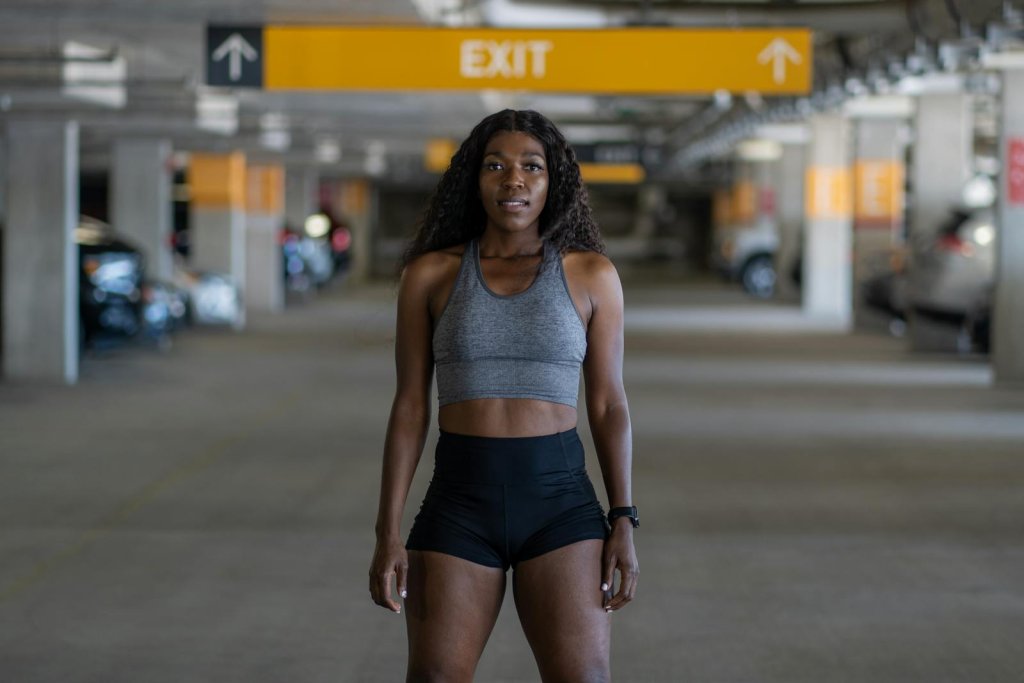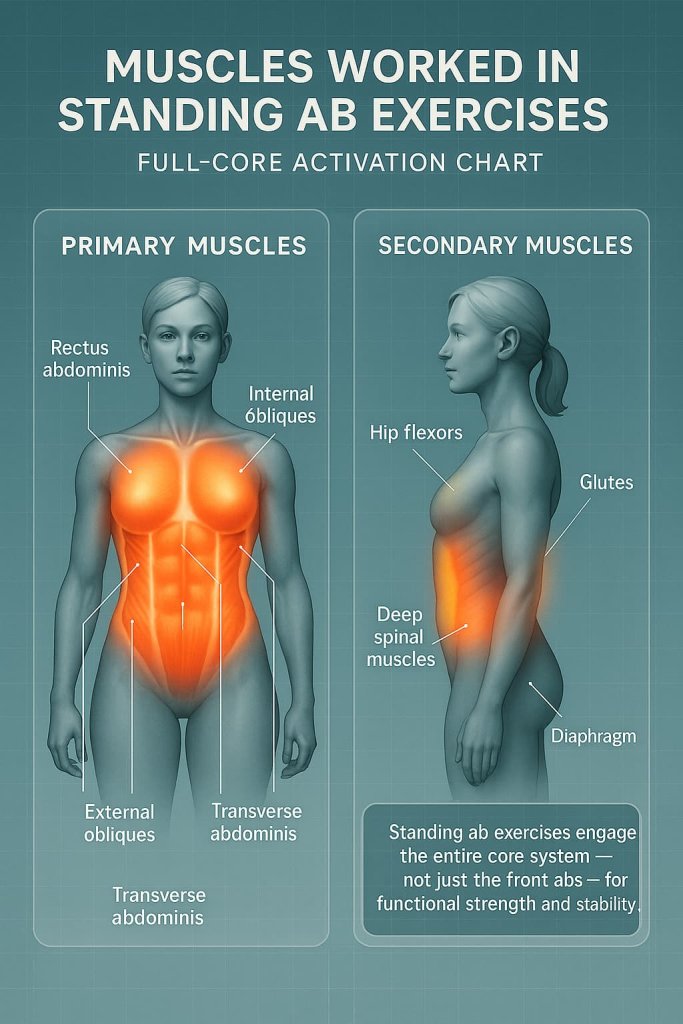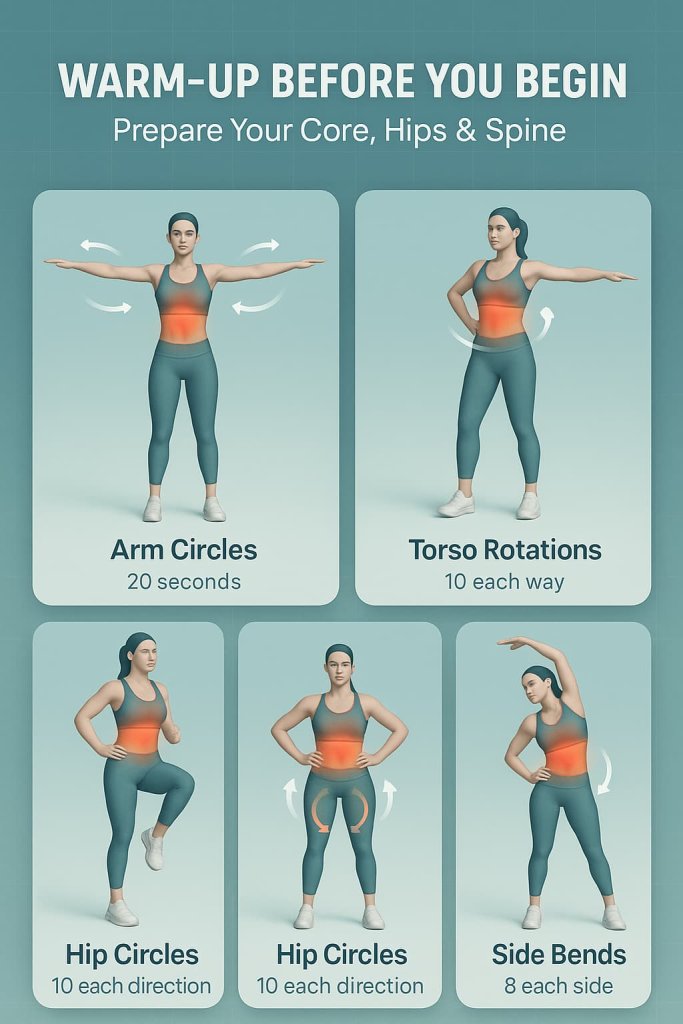Standing ab exercises can strengthen your core, improve posture, and tone your midsection without getting on the floor. These movements work your abs, obliques, hips, and lower back through natural, functional positions that support everyday movement. This makes them ideal for women who prefer low-impact, joint-friendly workouts or dislike traditional crunches.

Understanding how standing core training works helps you pick the safest, most effective exercises. Most moves involve rotation, anti-rotation, knee lifts, or diagonal patterns—each designed to target different layers of the abdominal muscles. These exercises are simple, accessible, and require little to no equipment.
Below is a detailed, research-supported list of the 15 best standing ab exercises for women, including benefits, form cues, and tips.
Benefits of Standing Ab Exercises for Women
Standing core work provides several advantages for strength, stability, and daily function:
- Builds core stability that supports posture and reduces lower-back strain

- Engages multiple muscle groups at once, increasing calorie burn
- Improves balance, coordination, and movement control
- Reduces pressure on the neck and lower back compared with floor crunches
- Supports athletic movement patterns like twisting, bending, and lifting
These movements also help integrate the core with the legs and upper body, which is essential for everyday tasks and long-term mobility.
Muscles Worked in Standing Ab Exercises
Standing ab exercises activate all major trunk muscles, including:
Primary Muscles
- Rectus abdominis
- External & internal obliques
- Transverse abdominis

Secondary Muscles
- Hip flexors
- Glutes
- Lower back stabilizers
- Deep spinal muscles
- Diaphragm (breathing stability)
This makes standing ab training a full-core approach rather than an isolated exercise.
Warm-Up Before You Begin
A quick warm-up prepares your core, improves mobility, and reduces back or hip strain.

Warm-Up (2–3 minutes):
- Arm circles – 20 seconds
- Torso rotations – 10 each way
- High knee march – 20 steps
- Hip circles – 10 each way
- Side bends – 8 each side
Trainer Tip: Move slowly and stay within a comfortable range.
The 15 Best Standing Ab Exercises for Women
Strengthen your core, improve balance, and sculpt your midsection with these effective standing ab exercises designed specifically for women. Each move is joint-friendly, beginner-friendly, and perfect for building a strong, toned core without getting on the floor.
1. Standing Knee-to-Elbow Crunch
Why it works:
This movement strengthens the rectus abdominis and obliques while improving coordination and core stability. Because you stand upright, it reduces neck and lower-back strain compared with floor crunches.
Muscles worked:
Rectus abdominis, external obliques, internal obliques, hip flexors.
How to do it:
- Stand tall with feet hip-width apart, hands behind your head.
- Lift your right knee toward your left elbow.
- Crunch your torso slightly as they move toward each other.
- Return to start and repeat on the opposite side.
Trainer Tip: Keep your chest lifted and core tight—avoid leaning too far forward.
2. Standing Bicycle Crunch
Why it works:
This dynamic rotational move enhances oblique activation while improving balance and mobility. It mimics the floor bicycle but avoids pressure on the neck.
Muscles worked:
Obliques, rectus abdominis, hip flexors.
How to do it:
- Lift your left knee toward your right elbow.
- Rotate your torso as they meet.
- Alternate sides in a smooth, controlled rhythm.
Trainer Tip: Slow, controlled reps activate the core more effectively than fast cycling.
3. High Knee Pull-Down
Why it works:
Combines upper-body pull-down motion with a strong knee drive, increasing calorie burn and total-body coordination. Great for activating the lower abs.
Muscles worked:
Lower abs, obliques, hip flexors, lats, shoulders.
How to do it:
- Reach both arms overhead.
- Pull your arms down as you drive one knee up toward your chest.
- Switch sides with a steady rhythm.
Trainer Tip: Pull down forcefully to intensify core contraction.
4. Side Bend Reach
Why it works:
Targets the obliques through lateral flexion while improving spine mobility. Helps shape the waist safely.
Muscles worked:
Obliques, quadratus lumborum, deep core stabilizers.
How to do it:
- Stand with feet hip-width apart.
- Slide one arm down your leg as you bend sideways.
- Switch sides in slow, controlled reps.
Trainer Tip: Keep hips square and still—avoid shifting side to side.
5. Standing Torso Twist
Why it works:
A gentle rotational exercise that improves core mobility and warms up the obliques and spinal muscles. Ideal for beginners.
Muscles worked:
Obliques, transverse abdominis, spinal rotators.
How to do it:
- Hold your arms at chest height.
- Twist left and right while keeping hips stable.
Trainer Tip: Exhale during each twist for stronger core activation.
6. Standing Oblique Crunch
Why it works:
Creates focused contraction through each side of the waist, helping strengthen and define the obliques.
Muscles worked:
Obliques, hip flexors, transverse abdominis.
How to do it:
- Stand with feet shoulder-width apart.
- Lift your right arm overhead.
- Crunch down as your right knee lifts toward your right elbow.
- Switch sides.
Trainer Tip: Think about shortening the side of your waist, not bending forward.
7. Marching Wood Chop
Why it works:
A functional, diagonal movement that trains rotational strength and enhances coordination between the hips and core.
Muscles worked:
Obliques, transverse abdominis, hip flexors, shoulders.
How to do it:
- Clasp your hands together like holding a handle.
- Chop diagonally from high to low as you lift the opposite knee.
- Switch sides.
Trainer Tip: Rotate through your upper torso, not your hips.
8. Standing Wood Chop (Band or Dumbbell)
Why it works:
Strengthens the diagonal core sling system responsible for rotation, stability, and athletic movement.
Muscles worked:
Obliques, rectus abdominis, lats, shoulders, deep trunk stabilizers.
How to do it:
- Hold a weight or band near one shoulder.
- Rotate downward across your body.
- Return with control and repeat on the other side.
Trainer Tip: Start with light weight—focus on slow, controlled rotation.
9. Pallof Press (Band Anti-Rotation Press)
Why it works:
A top exercise for deep core stability. It trains the body to resist rotation, strengthening the transverse abdominis and improving posture.
Muscles worked:
Transverse abdominis, obliques, deep spinal stabilizers, shoulders.
How to do it:
- Anchor a band at chest height.
- Step out to create tension.
- Press the band straight forward while resisting rotation.
Trainer Tip: Keep your body square—your goal is preventing movement, not creating it.
10. Standing Side Leg Lift with Oblique Squeeze
Why it works:
Targets the obliques while engaging hip abductors and improving balance.
Muscles worked:
Obliques, glute medius, hip abductors, transverse abdominis.
How to do it:
- Stand tall and lift one leg to the side.
- Squeeze your obliques as the leg rises.
- Switch sides.
Trainer Tip: Don’t lean sideways—let the obliques initiate the movement.
11. Standing Reverse Crunch
Why it works:
Mimics the lower-ab crunch without lying on your back. Ideal for women who want lower-ab activation without floor work.
Muscles worked:
Lower abs, hip flexors, deep core stabilizers.
How to do it:
- Hold a wall or chair for support.
- Lift both knees toward your chest while rounding your lower belly slightly.
Trainer Tip: Move slowly to avoid using momentum.
12. Standing Cross-Body Knee Drive
Why it works:
Engages the obliques and rectus abdominis while improving balance and coordination.
Muscles worked:
Obliques, rectus abdominis, hip flexors.
How to do it:
- Lift your right knee toward your left elbow.
- Add a controlled twist through your torso.
- Switch sides rhythmically.
Trainer Tip: Keep the twist slow and intentional for maximum oblique engagement.
13. Halo Rotation (Dumbbell or Plate)
Why it works:
Trains rotational control, shoulder mobility, and core stability. Keeps the torso braced while the arms move around the head.
Muscles worked:
Obliques, transverse abdominis, shoulders, upper back.
How to do it:
- Hold a dumbbell or plate at chest height.
- Circle it around your head in a controlled “halo.”
- Repeat in both directions.
Trainer Tip: Keep your torso completely still—brace your core throughout.
14. Standing Hip Hinge with Core Brace
Why it works:
Teaches proper hip hinge mechanics while training the deep stabilizers that support the spine and posture.
Muscles worked:
Lower abs, spinal erectors, glutes, hamstrings.
How to do it:
- Stand with feet hip-width apart.
- Brace your core.
- Hinge forward slightly at the hips.
- Return to standing tall.
Trainer Tip: Maintain a neutral spine—think “ribs down and core tight.”
15. Suitcase Carry (One-Side Hold Walk)
Why it works:
A standing plank in motion. Great for anti-lateral-flexion strength, posture, and everyday functional stability.
Muscles worked:
Obliques, transverse abdominis, quadratus lumborum, grip muscles, glutes.
How to do it:
- Hold a dumbbell on one side.
- Walk slowly while keeping your torso upright.
- Switch sides.
Trainer Tip: Keep shoulders level and avoid leaning—walk with control.
How Often Should Women Do Standing Ab Exercises?
For best results:
- 2–3 sessions per week
- 20–40 seconds per exercise, 2–3 rounds
- Pair with strength training, walking, or interval cardio
Gradually increase difficulty by adding resistance bands or light weights.
Safety Tips for Women
To stay safe and protect your spine, move with control and avoid excessive twisting.
Key Tips:
- Engage your core before each rep
- Rotate through your upper body, not your hips
- Avoid fast, jerky movements
- Use a wall or chair if balance feels unsteady
- Stop immediately if you feel pain
- Breathe steadily — don’t hold your breath
Trainer Tip: Women who are postpartum or have back issues should get clearance first.
Common Mistakes to Avoid
- Using momentum instead of muscle control
- Rotating the hips instead of the rib cage
- Holding breath during movements
- Letting shoulders shrug or torso collapse
- Moving too quickly for proper core activation
Small corrections greatly improve effectiveness and safety.
Who Should Avoid These Exercises?
Standing ab exercises are safe for most women, but certain conditions require caution.
Avoid or modify if you:
- Have acute lower-back pain
- Are early postpartum or have pelvic floor issues
- Experience dizziness or balance problems
- Have a hernia or recent abdominal surgery
- Feel sharp pain during twisting or knee lifts
Trainer Tip: Use smaller movements or anti-rotation exercises if unsure.
FAQ
1. Are standing ab exercises effective for toning the stomach?
Yes. They strengthen and tone abdominal muscles, but visible definition also depends on overall body fat levels.
2. Are standing ab exercises good for beginners?
Absolutely—many are low-impact and gentle on the back and neck.
3. Can I lose belly fat with standing ab exercises?
These exercises help strengthen your core, but fat loss comes from total activity, strength training, and nutrition.
4. Are weights necessary for standing ab workouts?
No. Most exercises can be done with bodyweight, though bands or light dumbbells add progression.
5. Do standing ab exercises help with posture?
Yes—core stabilization supports spinal alignment and reduces slouching.
6. Can pregnant women do standing ab exercises?
Many standing core exercises are pregnancy-friendly, but always consult a medical professional before starting or continuing exercise.
7. How long does it take to see results?
Most women feel stronger within 2–4 weeks with consistent training.
Conclusion
Standing ab exercises offer women an accessible, joint-friendly way to build core strength and sculpt a toned midsection without getting down on the floor. By combining rotation, anti-rotation, balance, and functional movement patterns, these exercises train your abs the way your body naturally moves throughout the day.
Start with a few beginner-friendly moves, progress slowly, and stay consistent for long-term results. Pair these exercises with regular cardio and strength training for a complete, balanced routine.
This content is for informational purposes only and not medical advice.
References
- Oliva-Lozano JM, Muyor JM. (2020). Core muscle activity during physical fitness exercises: A systematic review. Healthcare.
https://pmc.ncbi.nlm.nih.gov/articles/PMC7345922/ - Martuscello J et al. (2013). Systematic review of core muscle electromyographic activity during physical fitness exercises. Journal of Strength and Conditioning Research.
https://digitalcommons.usf.edu/cgi/viewcontent.cgi?article=5343&context=etd - Hlaing SS et al. (2021). Effects of core stabilization exercise and strengthening exercise on proprioception, balance, muscle thickness and pain in patients with subacute non-specific low back pain. BMC Musculoskeletal Disorders.
https://bmcmusculoskeletdisord.biomedcentral.com/articles/10.1186/s12891-021-04858-6 - Xu S et al. (2024). Interventional effect of core stability training on pain and lower back muscle function in chronic non-specific low back pain. Heliyon.
https://www.sciencedirect.com/science/article/pii/S2405844024088492 - Fradkin AJ et al. (2010). Effects of warming-up on physical performance: A systematic review with meta-analysis. Journal of Strength and Conditioning Research.
https://pubmed.ncbi.nlm.nih.gov/19996770/ - Li FY et al. (2023). Effects of different warm-up methods on explosive performance: A systematic review and net meta-analysis. BMC Sports Science, Medicine and Rehabilitation.
https://bmcsportsscimedrehabil.biomedcentral.com/articles/10.1186/s13102-023-00703-6 - Garber CE et al. (2011). Quantity and Quality of Exercise for Developing and Maintaining Fitness in Adults: ACSM Position Stand. Medicine & Science in Sports & Exercise.
https://pubmed.ncbi.nlm.nih.gov/21694556/ - Piercy KL et al. (2018). The Physical Activity Guidelines for Americans. JAMA.
https://pubmed.ncbi.nlm.nih.gov/30418471/
